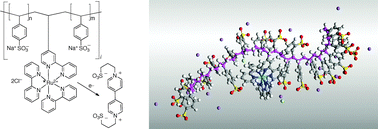Influence of polystyrenesulfonate on electron transfer quenching of ruthenium trisbipyridine luminescence by viologens: non-covalent assembly and covalent tethering of the ruthenium complex†
Abstract
A new

* Corresponding authors
a
School of Chemistry and Chemical nanoscience Laboratory, Bedson Building, University of Newcastle, Newcastle upon Tyne, England
E-mail:
eimer.tuite@ncl.ac.uk
Fax: +44 191 222 6929
Tel: +44 191 2225523
b
School of Chemical and Pharmaceutical Sciences, Dublin Institute of Technology, Kevin Street, Dublin 8, Ireland
E-mail:
patricia.ennis@dit.ie
c
School of Chemistry and Centre for Chemical Synthesis and Chemical Biology, Trinity College, Dublin 2, Ireland
E-mail:
jmkelly@tcd.ie
A new

 Please wait while we load your content...
Something went wrong. Try again?
Please wait while we load your content...
Something went wrong. Try again?
E. M. Tuite, D. B. Rose, P. M. Ennis and J. M. Kelly, Phys. Chem. Chem. Phys., 2012, 14, 3681 DOI: 10.1039/C2CP23597H
To request permission to reproduce material from this article, please go to the Copyright Clearance Center request page.
If you are an author contributing to an RSC publication, you do not need to request permission provided correct acknowledgement is given.
If you are the author of this article, you do not need to request permission to reproduce figures and diagrams provided correct acknowledgement is given. If you want to reproduce the whole article in a third-party publication (excluding your thesis/dissertation for which permission is not required) please go to the Copyright Clearance Center request page.
Read more about how to correctly acknowledge RSC content.
 Fetching data from CrossRef.
Fetching data from CrossRef.
This may take some time to load.
Loading related content
